Purchase Intention of Luxury Brands: Literature Review Analysis
VerifiedAdded on 2023/04/05
|25
|6324
|485
Report
AI Summary
This document presents a comprehensive literature review focusing on the influence of social influencers on the purchase intention of luxury brands, particularly among Generations X, Y, and Z. It begins with an introduction defining the scope of the research and its objectives. The review explores key concepts such as social influencers, social media's role in marketing, and the definition of purchase intention. It delves into the impact of influencers on consumer behavior, the use of social media platforms for brand promotion, and the factors affecting purchase decisions, including reputation, attractiveness, product characteristics, and sales promotion. The review synthesizes insights from various academic sources, discussing the evolution of marketing communication, the importance of social media, and the dynamics of consumer decision-making. Furthermore, the review examines the mediating roles of social earnings and customer trust in the relationship between different factors and purchase intention. The document also outlines the conceptual and management theory frameworks supporting the research and highlights the development of hypotheses to be tested. This literature review provides a foundation for understanding the complex interplay between social influences and consumer behavior in the luxury brand market. The assignment is contributed by a student to be published on the website Desklib, a platform which provides all the necessary AI based study tools for students.
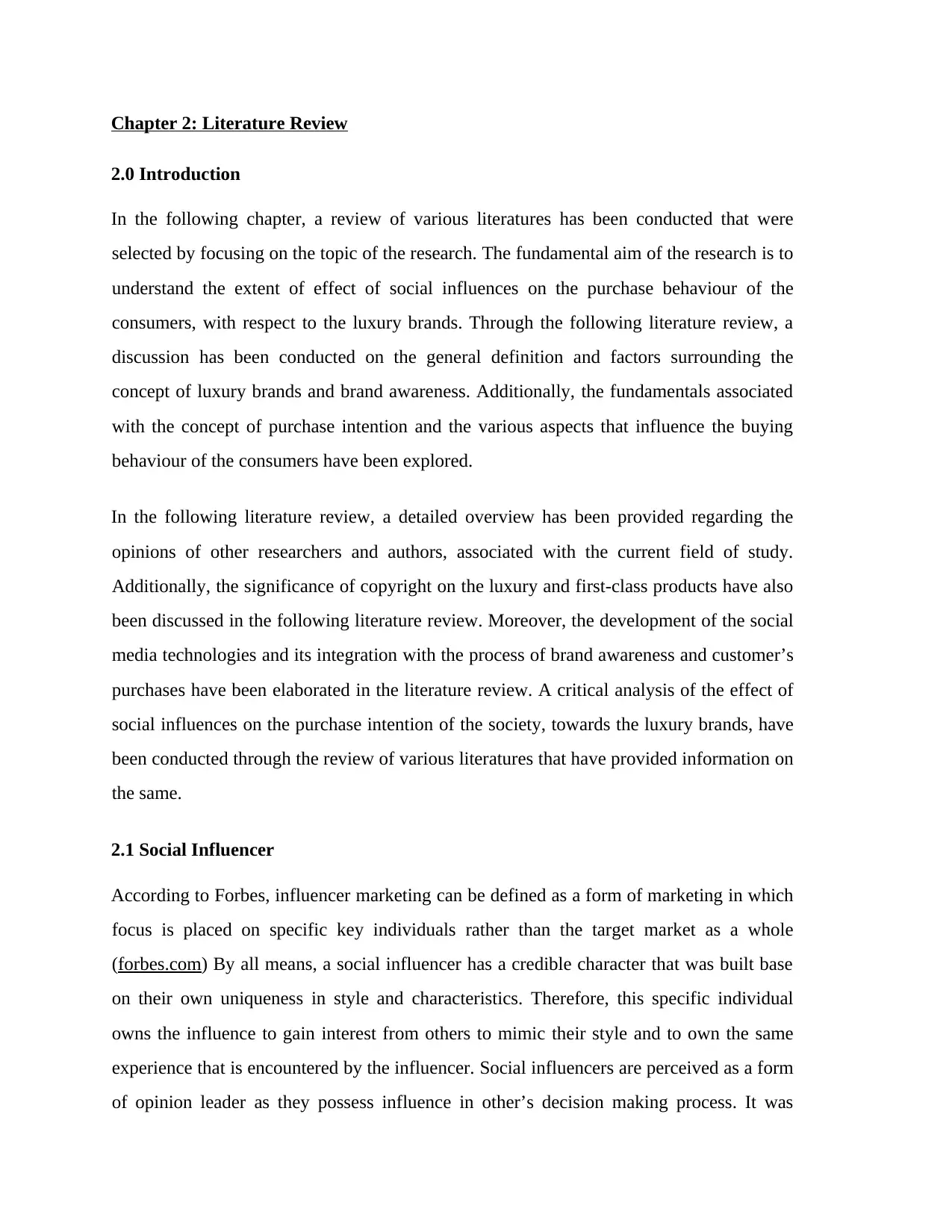
Chapter 2: Literature Review
2.0 Introduction
In the following chapter, a review of various literatures has been conducted that were
selected by focusing on the topic of the research. The fundamental aim of the research is to
understand the extent of effect of social influences on the purchase behaviour of the
consumers, with respect to the luxury brands. Through the following literature review, a
discussion has been conducted on the general definition and factors surrounding the
concept of luxury brands and brand awareness. Additionally, the fundamentals associated
with the concept of purchase intention and the various aspects that influence the buying
behaviour of the consumers have been explored.
In the following literature review, a detailed overview has been provided regarding the
opinions of other researchers and authors, associated with the current field of study.
Additionally, the significance of copyright on the luxury and first-class products have also
been discussed in the following literature review. Moreover, the development of the social
media technologies and its integration with the process of brand awareness and customer’s
purchases have been elaborated in the literature review. A critical analysis of the effect of
social influences on the purchase intention of the society, towards the luxury brands, have
been conducted through the review of various literatures that have provided information on
the same.
2.1 Social Influencer
According to Forbes, influencer marketing can be defined as a form of marketing in which
focus is placed on specific key individuals rather than the target market as a whole
(forbes.com) By all means, a social influencer has a credible character that was built base
on their own uniqueness in style and characteristics. Therefore, this specific individual
owns the influence to gain interest from others to mimic their style and to own the same
experience that is encountered by the influencer. Social influencers are perceived as a form
of opinion leader as they possess influence in other’s decision making process. It was
2.0 Introduction
In the following chapter, a review of various literatures has been conducted that were
selected by focusing on the topic of the research. The fundamental aim of the research is to
understand the extent of effect of social influences on the purchase behaviour of the
consumers, with respect to the luxury brands. Through the following literature review, a
discussion has been conducted on the general definition and factors surrounding the
concept of luxury brands and brand awareness. Additionally, the fundamentals associated
with the concept of purchase intention and the various aspects that influence the buying
behaviour of the consumers have been explored.
In the following literature review, a detailed overview has been provided regarding the
opinions of other researchers and authors, associated with the current field of study.
Additionally, the significance of copyright on the luxury and first-class products have also
been discussed in the following literature review. Moreover, the development of the social
media technologies and its integration with the process of brand awareness and customer’s
purchases have been elaborated in the literature review. A critical analysis of the effect of
social influences on the purchase intention of the society, towards the luxury brands, have
been conducted through the review of various literatures that have provided information on
the same.
2.1 Social Influencer
According to Forbes, influencer marketing can be defined as a form of marketing in which
focus is placed on specific key individuals rather than the target market as a whole
(forbes.com) By all means, a social influencer has a credible character that was built base
on their own uniqueness in style and characteristics. Therefore, this specific individual
owns the influence to gain interest from others to mimic their style and to own the same
experience that is encountered by the influencer. Social influencers are perceived as a form
of opinion leader as they possess influence in other’s decision making process. It was
Paraphrase This Document
Need a fresh take? Get an instant paraphrase of this document with our AI Paraphraser
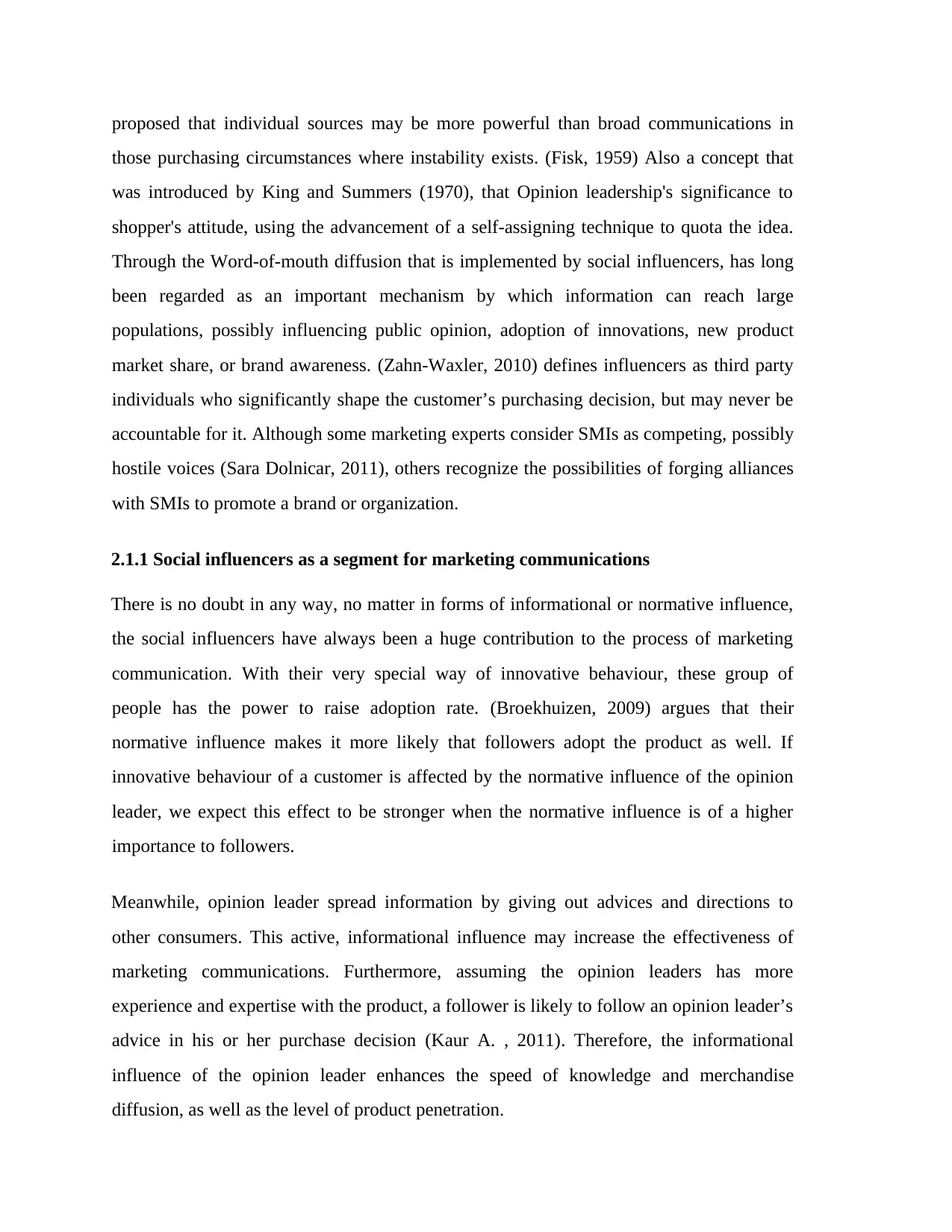
proposed that individual sources may be more powerful than broad communications in
those purchasing circumstances where instability exists. (Fisk, 1959) Also a concept that
was introduced by King and Summers (1970), that Opinion leadership's significance to
shopper's attitude, using the advancement of a self-assigning technique to quota the idea.
Through the Word-of-mouth diffusion that is implemented by social influencers, has long
been regarded as an important mechanism by which information can reach large
populations, possibly influencing public opinion, adoption of innovations, new product
market share, or brand awareness. (Zahn-Waxler, 2010) defines influencers as third party
individuals who significantly shape the customer’s purchasing decision, but may never be
accountable for it. Although some marketing experts consider SMIs as competing, possibly
hostile voices (Sara Dolnicar, 2011), others recognize the possibilities of forging alliances
with SMIs to promote a brand or organization.
2.1.1 Social influencers as a segment for marketing communications
There is no doubt in any way, no matter in forms of informational or normative influence,
the social influencers have always been a huge contribution to the process of marketing
communication. With their very special way of innovative behaviour, these group of
people has the power to raise adoption rate. (Broekhuizen, 2009) argues that their
normative influence makes it more likely that followers adopt the product as well. If
innovative behaviour of a customer is affected by the normative influence of the opinion
leader, we expect this effect to be stronger when the normative influence is of a higher
importance to followers.
Meanwhile, opinion leader spread information by giving out advices and directions to
other consumers. This active, informational influence may increase the effectiveness of
marketing communications. Furthermore, assuming the opinion leaders has more
experience and expertise with the product, a follower is likely to follow an opinion leader’s
advice in his or her purchase decision (Kaur A. , 2011). Therefore, the informational
influence of the opinion leader enhances the speed of knowledge and merchandise
diffusion, as well as the level of product penetration.
those purchasing circumstances where instability exists. (Fisk, 1959) Also a concept that
was introduced by King and Summers (1970), that Opinion leadership's significance to
shopper's attitude, using the advancement of a self-assigning technique to quota the idea.
Through the Word-of-mouth diffusion that is implemented by social influencers, has long
been regarded as an important mechanism by which information can reach large
populations, possibly influencing public opinion, adoption of innovations, new product
market share, or brand awareness. (Zahn-Waxler, 2010) defines influencers as third party
individuals who significantly shape the customer’s purchasing decision, but may never be
accountable for it. Although some marketing experts consider SMIs as competing, possibly
hostile voices (Sara Dolnicar, 2011), others recognize the possibilities of forging alliances
with SMIs to promote a brand or organization.
2.1.1 Social influencers as a segment for marketing communications
There is no doubt in any way, no matter in forms of informational or normative influence,
the social influencers have always been a huge contribution to the process of marketing
communication. With their very special way of innovative behaviour, these group of
people has the power to raise adoption rate. (Broekhuizen, 2009) argues that their
normative influence makes it more likely that followers adopt the product as well. If
innovative behaviour of a customer is affected by the normative influence of the opinion
leader, we expect this effect to be stronger when the normative influence is of a higher
importance to followers.
Meanwhile, opinion leader spread information by giving out advices and directions to
other consumers. This active, informational influence may increase the effectiveness of
marketing communications. Furthermore, assuming the opinion leaders has more
experience and expertise with the product, a follower is likely to follow an opinion leader’s
advice in his or her purchase decision (Kaur A. , 2011). Therefore, the informational
influence of the opinion leader enhances the speed of knowledge and merchandise
diffusion, as well as the level of product penetration.
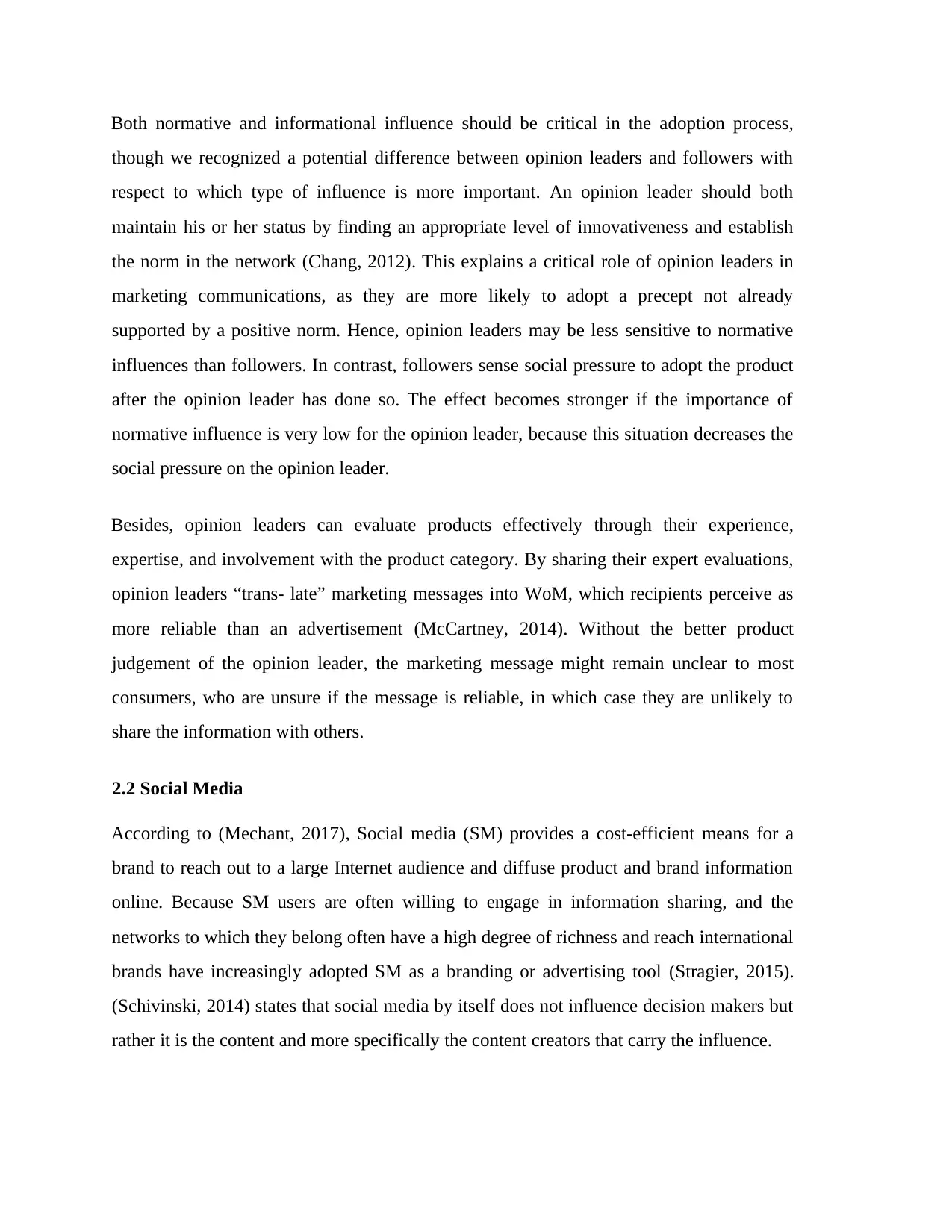
Both normative and informational influence should be critical in the adoption process,
though we recognized a potential difference between opinion leaders and followers with
respect to which type of influence is more important. An opinion leader should both
maintain his or her status by finding an appropriate level of innovativeness and establish
the norm in the network (Chang, 2012). This explains a critical role of opinion leaders in
marketing communications, as they are more likely to adopt a precept not already
supported by a positive norm. Hence, opinion leaders may be less sensitive to normative
influences than followers. In contrast, followers sense social pressure to adopt the product
after the opinion leader has done so. The effect becomes stronger if the importance of
normative influence is very low for the opinion leader, because this situation decreases the
social pressure on the opinion leader.
Besides, opinion leaders can evaluate products effectively through their experience,
expertise, and involvement with the product category. By sharing their expert evaluations,
opinion leaders “trans- late” marketing messages into WoM, which recipients perceive as
more reliable than an advertisement (McCartney, 2014). Without the better product
judgement of the opinion leader, the marketing message might remain unclear to most
consumers, who are unsure if the message is reliable, in which case they are unlikely to
share the information with others.
2.2 Social Media
According to (Mechant, 2017), Social media (SM) provides a cost-efficient means for a
brand to reach out to a large Internet audience and diffuse product and brand information
online. Because SM users are often willing to engage in information sharing, and the
networks to which they belong often have a high degree of richness and reach international
brands have increasingly adopted SM as a branding or advertising tool (Stragier, 2015).
(Schivinski, 2014) states that social media by itself does not influence decision makers but
rather it is the content and more specifically the content creators that carry the influence.
though we recognized a potential difference between opinion leaders and followers with
respect to which type of influence is more important. An opinion leader should both
maintain his or her status by finding an appropriate level of innovativeness and establish
the norm in the network (Chang, 2012). This explains a critical role of opinion leaders in
marketing communications, as they are more likely to adopt a precept not already
supported by a positive norm. Hence, opinion leaders may be less sensitive to normative
influences than followers. In contrast, followers sense social pressure to adopt the product
after the opinion leader has done so. The effect becomes stronger if the importance of
normative influence is very low for the opinion leader, because this situation decreases the
social pressure on the opinion leader.
Besides, opinion leaders can evaluate products effectively through their experience,
expertise, and involvement with the product category. By sharing their expert evaluations,
opinion leaders “trans- late” marketing messages into WoM, which recipients perceive as
more reliable than an advertisement (McCartney, 2014). Without the better product
judgement of the opinion leader, the marketing message might remain unclear to most
consumers, who are unsure if the message is reliable, in which case they are unlikely to
share the information with others.
2.2 Social Media
According to (Mechant, 2017), Social media (SM) provides a cost-efficient means for a
brand to reach out to a large Internet audience and diffuse product and brand information
online. Because SM users are often willing to engage in information sharing, and the
networks to which they belong often have a high degree of richness and reach international
brands have increasingly adopted SM as a branding or advertising tool (Stragier, 2015).
(Schivinski, 2014) states that social media by itself does not influence decision makers but
rather it is the content and more specifically the content creators that carry the influence.
⊘ This is a preview!⊘
Do you want full access?
Subscribe today to unlock all pages.

Trusted by 1+ million students worldwide
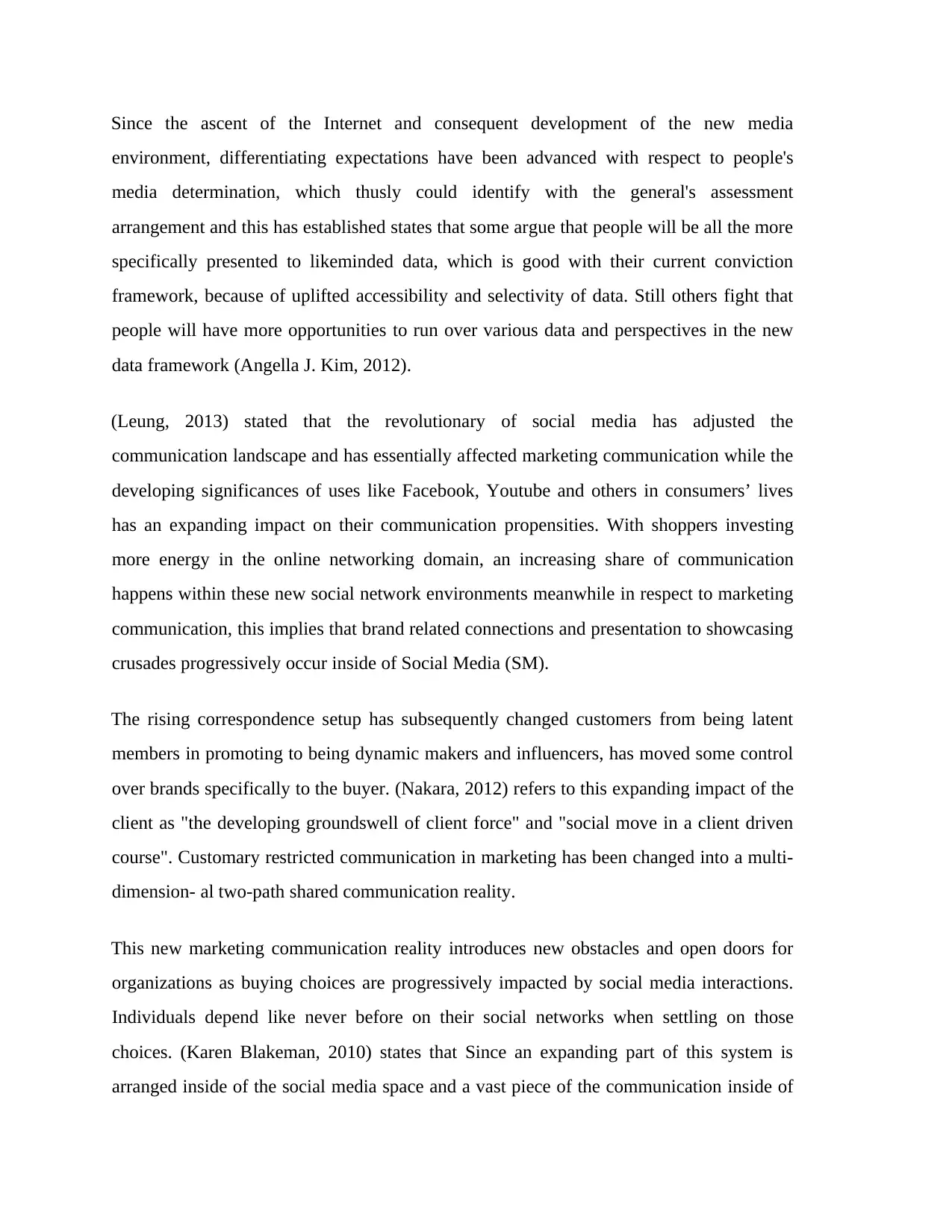
Since the ascent of the Internet and consequent development of the new media
environment, differentiating expectations have been advanced with respect to people's
media determination, which thusly could identify with the general's assessment
arrangement and this has established states that some argue that people will be all the more
specifically presented to likeminded data, which is good with their current conviction
framework, because of uplifted accessibility and selectivity of data. Still others fight that
people will have more opportunities to run over various data and perspectives in the new
data framework (Angella J. Kim, 2012).
(Leung, 2013) stated that the revolutionary of social media has adjusted the
communication landscape and has essentially affected marketing communication while the
developing significances of uses like Facebook, Youtube and others in consumers’ lives
has an expanding impact on their communication propensities. With shoppers investing
more energy in the online networking domain, an increasing share of communication
happens within these new social network environments meanwhile in respect to marketing
communication, this implies that brand related connections and presentation to showcasing
crusades progressively occur inside of Social Media (SM).
The rising correspondence setup has subsequently changed customers from being latent
members in promoting to being dynamic makers and influencers, has moved some control
over brands specifically to the buyer. (Nakara, 2012) refers to this expanding impact of the
client as "the developing groundswell of client force" and "social move in a client driven
course". Customary restricted communication in marketing has been changed into a multi-
dimension- al two-path shared communication reality.
This new marketing communication reality introduces new obstacles and open doors for
organizations as buying choices are progressively impacted by social media interactions.
Individuals depend like never before on their social networks when settling on those
choices. (Karen Blakeman, 2010) states that Since an expanding part of this system is
arranged inside of the social media space and a vast piece of the communication inside of
environment, differentiating expectations have been advanced with respect to people's
media determination, which thusly could identify with the general's assessment
arrangement and this has established states that some argue that people will be all the more
specifically presented to likeminded data, which is good with their current conviction
framework, because of uplifted accessibility and selectivity of data. Still others fight that
people will have more opportunities to run over various data and perspectives in the new
data framework (Angella J. Kim, 2012).
(Leung, 2013) stated that the revolutionary of social media has adjusted the
communication landscape and has essentially affected marketing communication while the
developing significances of uses like Facebook, Youtube and others in consumers’ lives
has an expanding impact on their communication propensities. With shoppers investing
more energy in the online networking domain, an increasing share of communication
happens within these new social network environments meanwhile in respect to marketing
communication, this implies that brand related connections and presentation to showcasing
crusades progressively occur inside of Social Media (SM).
The rising correspondence setup has subsequently changed customers from being latent
members in promoting to being dynamic makers and influencers, has moved some control
over brands specifically to the buyer. (Nakara, 2012) refers to this expanding impact of the
client as "the developing groundswell of client force" and "social move in a client driven
course". Customary restricted communication in marketing has been changed into a multi-
dimension- al two-path shared communication reality.
This new marketing communication reality introduces new obstacles and open doors for
organizations as buying choices are progressively impacted by social media interactions.
Individuals depend like never before on their social networks when settling on those
choices. (Karen Blakeman, 2010) states that Since an expanding part of this system is
arranged inside of the social media space and a vast piece of the communication inside of
Paraphrase This Document
Need a fresh take? Get an instant paraphrase of this document with our AI Paraphraser
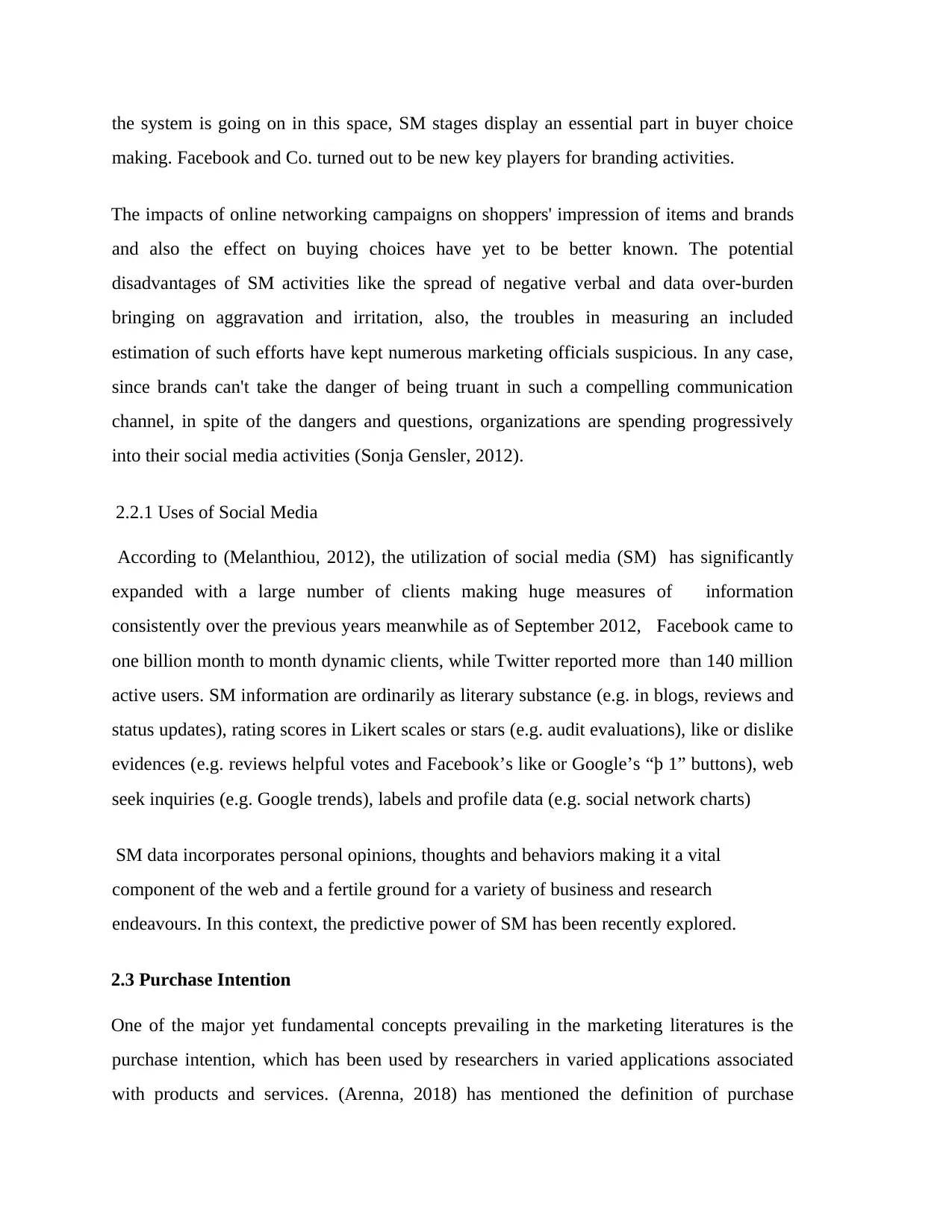
the system is going on in this space, SM stages display an essential part in buyer choice
making. Facebook and Co. turned out to be new key players for branding activities.
The impacts of online networking campaigns on shoppers' impression of items and brands
and also the effect on buying choices have yet to be better known. The potential
disadvantages of SM activities like the spread of negative verbal and data over-burden
bringing on aggravation and irritation, also, the troubles in measuring an included
estimation of such efforts have kept numerous marketing officials suspicious. In any case,
since brands can't take the danger of being truant in such a compelling communication
channel, in spite of the dangers and questions, organizations are spending progressively
into their social media activities (Sonja Gensler, 2012).
2.2.1 Uses of Social Media
According to (Melanthiou, 2012), the utilization of social media (SM) has significantly
expanded with a large number of clients making huge measures of information
consistently over the previous years meanwhile as of September 2012, Facebook came to
one billion month to month dynamic clients, while Twitter reported more than 140 million
active users. SM information are ordinarily as literary substance (e.g. in blogs, reviews and
status updates), rating scores in Likert scales or stars (e.g. audit evaluations), like or dislike
evidences (e.g. reviews helpful votes and Facebook’s like or Google’s “þ 1” buttons), web
seek inquiries (e.g. Google trends), labels and profile data (e.g. social network charts)
SM data incorporates personal opinions, thoughts and behaviors making it a vital
component of the web and a fertile ground for a variety of business and research
endeavours. In this context, the predictive power of SM has been recently explored.
2.3 Purchase Intention
One of the major yet fundamental concepts prevailing in the marketing literatures is the
purchase intention, which has been used by researchers in varied applications associated
with products and services. (Arenna, 2018) has mentioned the definition of purchase
making. Facebook and Co. turned out to be new key players for branding activities.
The impacts of online networking campaigns on shoppers' impression of items and brands
and also the effect on buying choices have yet to be better known. The potential
disadvantages of SM activities like the spread of negative verbal and data over-burden
bringing on aggravation and irritation, also, the troubles in measuring an included
estimation of such efforts have kept numerous marketing officials suspicious. In any case,
since brands can't take the danger of being truant in such a compelling communication
channel, in spite of the dangers and questions, organizations are spending progressively
into their social media activities (Sonja Gensler, 2012).
2.2.1 Uses of Social Media
According to (Melanthiou, 2012), the utilization of social media (SM) has significantly
expanded with a large number of clients making huge measures of information
consistently over the previous years meanwhile as of September 2012, Facebook came to
one billion month to month dynamic clients, while Twitter reported more than 140 million
active users. SM information are ordinarily as literary substance (e.g. in blogs, reviews and
status updates), rating scores in Likert scales or stars (e.g. audit evaluations), like or dislike
evidences (e.g. reviews helpful votes and Facebook’s like or Google’s “þ 1” buttons), web
seek inquiries (e.g. Google trends), labels and profile data (e.g. social network charts)
SM data incorporates personal opinions, thoughts and behaviors making it a vital
component of the web and a fertile ground for a variety of business and research
endeavours. In this context, the predictive power of SM has been recently explored.
2.3 Purchase Intention
One of the major yet fundamental concepts prevailing in the marketing literatures is the
purchase intention, which has been used by researchers in varied applications associated
with products and services. (Arenna, 2018) has mentioned the definition of purchase
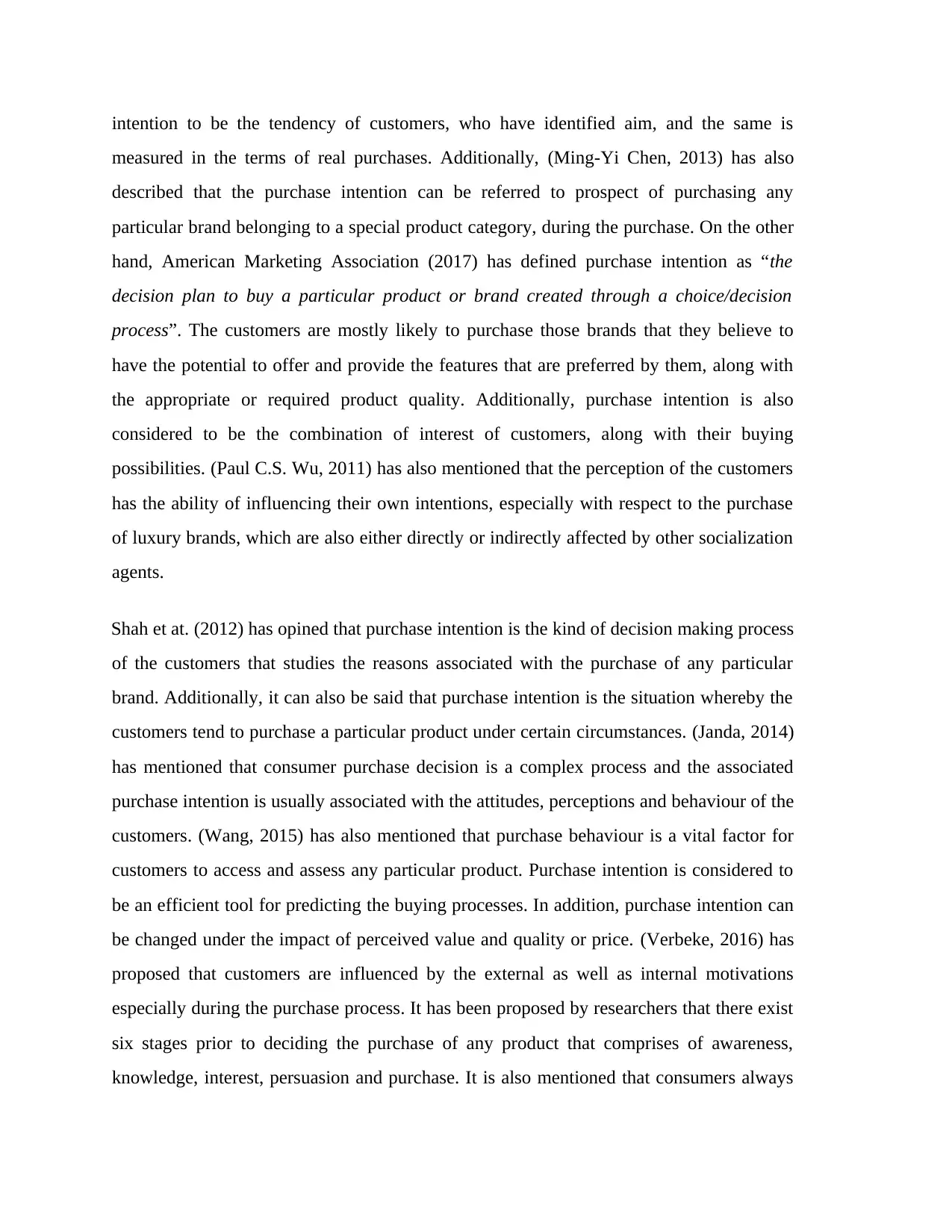
intention to be the tendency of customers, who have identified aim, and the same is
measured in the terms of real purchases. Additionally, (Ming-Yi Chen, 2013) has also
described that the purchase intention can be referred to prospect of purchasing any
particular brand belonging to a special product category, during the purchase. On the other
hand, American Marketing Association (2017) has defined purchase intention as “the
decision plan to buy a particular product or brand created through a choice/decision
process”. The customers are mostly likely to purchase those brands that they believe to
have the potential to offer and provide the features that are preferred by them, along with
the appropriate or required product quality. Additionally, purchase intention is also
considered to be the combination of interest of customers, along with their buying
possibilities. (Paul C.S. Wu, 2011) has also mentioned that the perception of the customers
has the ability of influencing their own intentions, especially with respect to the purchase
of luxury brands, which are also either directly or indirectly affected by other socialization
agents.
Shah et at. (2012) has opined that purchase intention is the kind of decision making process
of the customers that studies the reasons associated with the purchase of any particular
brand. Additionally, it can also be said that purchase intention is the situation whereby the
customers tend to purchase a particular product under certain circumstances. (Janda, 2014)
has mentioned that consumer purchase decision is a complex process and the associated
purchase intention is usually associated with the attitudes, perceptions and behaviour of the
customers. (Wang, 2015) has also mentioned that purchase behaviour is a vital factor for
customers to access and assess any particular product. Purchase intention is considered to
be an efficient tool for predicting the buying processes. In addition, purchase intention can
be changed under the impact of perceived value and quality or price. (Verbeke, 2016) has
proposed that customers are influenced by the external as well as internal motivations
especially during the purchase process. It has been proposed by researchers that there exist
six stages prior to deciding the purchase of any product that comprises of awareness,
knowledge, interest, persuasion and purchase. It is also mentioned that consumers always
measured in the terms of real purchases. Additionally, (Ming-Yi Chen, 2013) has also
described that the purchase intention can be referred to prospect of purchasing any
particular brand belonging to a special product category, during the purchase. On the other
hand, American Marketing Association (2017) has defined purchase intention as “the
decision plan to buy a particular product or brand created through a choice/decision
process”. The customers are mostly likely to purchase those brands that they believe to
have the potential to offer and provide the features that are preferred by them, along with
the appropriate or required product quality. Additionally, purchase intention is also
considered to be the combination of interest of customers, along with their buying
possibilities. (Paul C.S. Wu, 2011) has also mentioned that the perception of the customers
has the ability of influencing their own intentions, especially with respect to the purchase
of luxury brands, which are also either directly or indirectly affected by other socialization
agents.
Shah et at. (2012) has opined that purchase intention is the kind of decision making process
of the customers that studies the reasons associated with the purchase of any particular
brand. Additionally, it can also be said that purchase intention is the situation whereby the
customers tend to purchase a particular product under certain circumstances. (Janda, 2014)
has mentioned that consumer purchase decision is a complex process and the associated
purchase intention is usually associated with the attitudes, perceptions and behaviour of the
customers. (Wang, 2015) has also mentioned that purchase behaviour is a vital factor for
customers to access and assess any particular product. Purchase intention is considered to
be an efficient tool for predicting the buying processes. In addition, purchase intention can
be changed under the impact of perceived value and quality or price. (Verbeke, 2016) has
proposed that customers are influenced by the external as well as internal motivations
especially during the purchase process. It has been proposed by researchers that there exist
six stages prior to deciding the purchase of any product that comprises of awareness,
knowledge, interest, persuasion and purchase. It is also mentioned that consumers always
⊘ This is a preview!⊘
Do you want full access?
Subscribe today to unlock all pages.

Trusted by 1+ million students worldwide
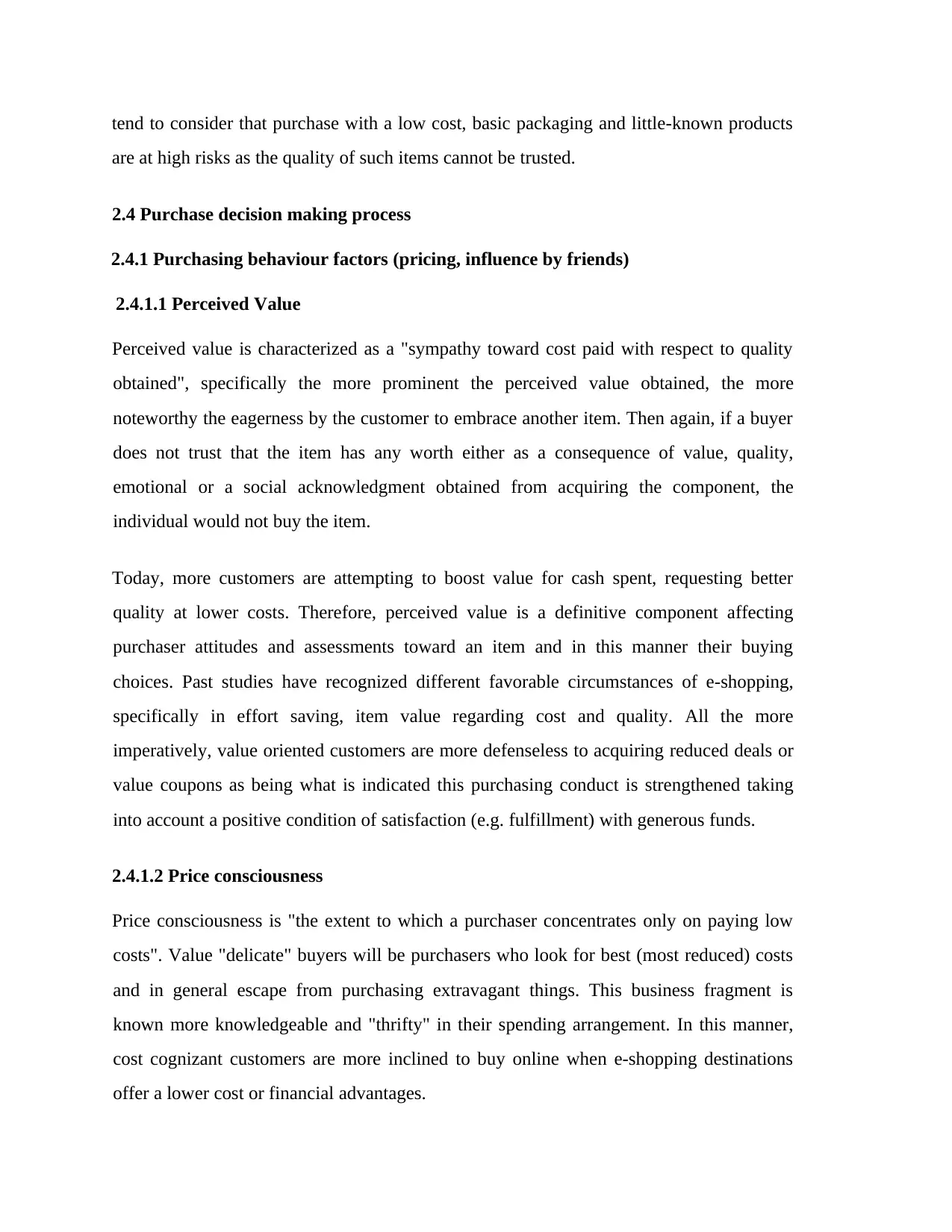
tend to consider that purchase with a low cost, basic packaging and little-known products
are at high risks as the quality of such items cannot be trusted.
2.4 Purchase decision making process
2.4.1 Purchasing behaviour factors (pricing, influence by friends)
2.4.1.1 Perceived Value
Perceived value is characterized as a "sympathy toward cost paid with respect to quality
obtained", specifically the more prominent the perceived value obtained, the more
noteworthy the eagerness by the customer to embrace another item. Then again, if a buyer
does not trust that the item has any worth either as a consequence of value, quality,
emotional or a social acknowledgment obtained from acquiring the component, the
individual would not buy the item.
Today, more customers are attempting to boost value for cash spent, requesting better
quality at lower costs. Therefore, perceived value is a definitive component affecting
purchaser attitudes and assessments toward an item and in this manner their buying
choices. Past studies have recognized different favorable circumstances of e-shopping,
specifically in effort saving, item value regarding cost and quality. All the more
imperatively, value oriented customers are more defenseless to acquiring reduced deals or
value coupons as being what is indicated this purchasing conduct is strengthened taking
into account a positive condition of satisfaction (e.g. fulfillment) with generous funds.
2.4.1.2 Price consciousness
Price consciousness is "the extent to which a purchaser concentrates only on paying low
costs". Value "delicate" buyers will be purchasers who look for best (most reduced) costs
and in general escape from purchasing extravagant things. This business fragment is
known more knowledgeable and "thrifty" in their spending arrangement. In this manner,
cost cognizant customers are more inclined to buy online when e-shopping destinations
offer a lower cost or financial advantages.
are at high risks as the quality of such items cannot be trusted.
2.4 Purchase decision making process
2.4.1 Purchasing behaviour factors (pricing, influence by friends)
2.4.1.1 Perceived Value
Perceived value is characterized as a "sympathy toward cost paid with respect to quality
obtained", specifically the more prominent the perceived value obtained, the more
noteworthy the eagerness by the customer to embrace another item. Then again, if a buyer
does not trust that the item has any worth either as a consequence of value, quality,
emotional or a social acknowledgment obtained from acquiring the component, the
individual would not buy the item.
Today, more customers are attempting to boost value for cash spent, requesting better
quality at lower costs. Therefore, perceived value is a definitive component affecting
purchaser attitudes and assessments toward an item and in this manner their buying
choices. Past studies have recognized different favorable circumstances of e-shopping,
specifically in effort saving, item value regarding cost and quality. All the more
imperatively, value oriented customers are more defenseless to acquiring reduced deals or
value coupons as being what is indicated this purchasing conduct is strengthened taking
into account a positive condition of satisfaction (e.g. fulfillment) with generous funds.
2.4.1.2 Price consciousness
Price consciousness is "the extent to which a purchaser concentrates only on paying low
costs". Value "delicate" buyers will be purchasers who look for best (most reduced) costs
and in general escape from purchasing extravagant things. This business fragment is
known more knowledgeable and "thrifty" in their spending arrangement. In this manner,
cost cognizant customers are more inclined to buy online when e-shopping destinations
offer a lower cost or financial advantages.
Paraphrase This Document
Need a fresh take? Get an instant paraphrase of this document with our AI Paraphraser
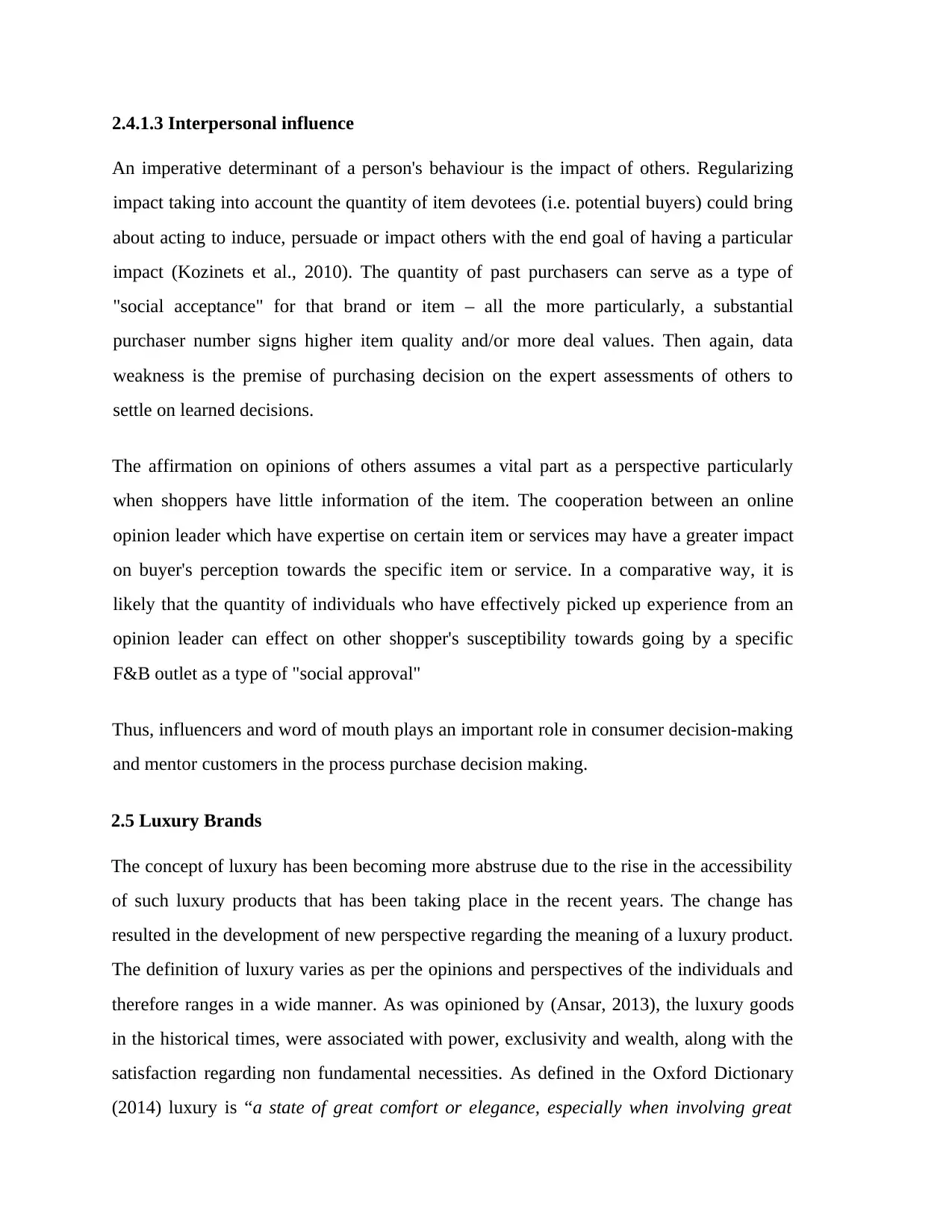
2.4.1.3 Interpersonal influence
An imperative determinant of a person's behaviour is the impact of others. Regularizing
impact taking into account the quantity of item devotees (i.e. potential buyers) could bring
about acting to induce, persuade or impact others with the end goal of having a particular
impact (Kozinets et al., 2010). The quantity of past purchasers can serve as a type of
"social acceptance" for that brand or item – all the more particularly, a substantial
purchaser number signs higher item quality and/or more deal values. Then again, data
weakness is the premise of purchasing decision on the expert assessments of others to
settle on learned decisions.
The affirmation on opinions of others assumes a vital part as a perspective particularly
when shoppers have little information of the item. The cooperation between an online
opinion leader which have expertise on certain item or services may have a greater impact
on buyer's perception towards the specific item or service. In a comparative way, it is
likely that the quantity of individuals who have effectively picked up experience from an
opinion leader can effect on other shopper's susceptibility towards going by a specific
F&B outlet as a type of "social approval"
Thus, influencers and word of mouth plays an important role in consumer decision-making
and mentor customers in the process purchase decision making.
2.5 Luxury Brands
The concept of luxury has been becoming more abstruse due to the rise in the accessibility
of such luxury products that has been taking place in the recent years. The change has
resulted in the development of new perspective regarding the meaning of a luxury product.
The definition of luxury varies as per the opinions and perspectives of the individuals and
therefore ranges in a wide manner. As was opinioned by (Ansar, 2013), the luxury goods
in the historical times, were associated with power, exclusivity and wealth, along with the
satisfaction regarding non fundamental necessities. As defined in the Oxford Dictionary
(2014) luxury is “a state of great comfort or elegance, especially when involving great
An imperative determinant of a person's behaviour is the impact of others. Regularizing
impact taking into account the quantity of item devotees (i.e. potential buyers) could bring
about acting to induce, persuade or impact others with the end goal of having a particular
impact (Kozinets et al., 2010). The quantity of past purchasers can serve as a type of
"social acceptance" for that brand or item – all the more particularly, a substantial
purchaser number signs higher item quality and/or more deal values. Then again, data
weakness is the premise of purchasing decision on the expert assessments of others to
settle on learned decisions.
The affirmation on opinions of others assumes a vital part as a perspective particularly
when shoppers have little information of the item. The cooperation between an online
opinion leader which have expertise on certain item or services may have a greater impact
on buyer's perception towards the specific item or service. In a comparative way, it is
likely that the quantity of individuals who have effectively picked up experience from an
opinion leader can effect on other shopper's susceptibility towards going by a specific
F&B outlet as a type of "social approval"
Thus, influencers and word of mouth plays an important role in consumer decision-making
and mentor customers in the process purchase decision making.
2.5 Luxury Brands
The concept of luxury has been becoming more abstruse due to the rise in the accessibility
of such luxury products that has been taking place in the recent years. The change has
resulted in the development of new perspective regarding the meaning of a luxury product.
The definition of luxury varies as per the opinions and perspectives of the individuals and
therefore ranges in a wide manner. As was opinioned by (Ansar, 2013), the luxury goods
in the historical times, were associated with power, exclusivity and wealth, along with the
satisfaction regarding non fundamental necessities. As defined in the Oxford Dictionary
(2014) luxury is “a state of great comfort or elegance, especially when involving great
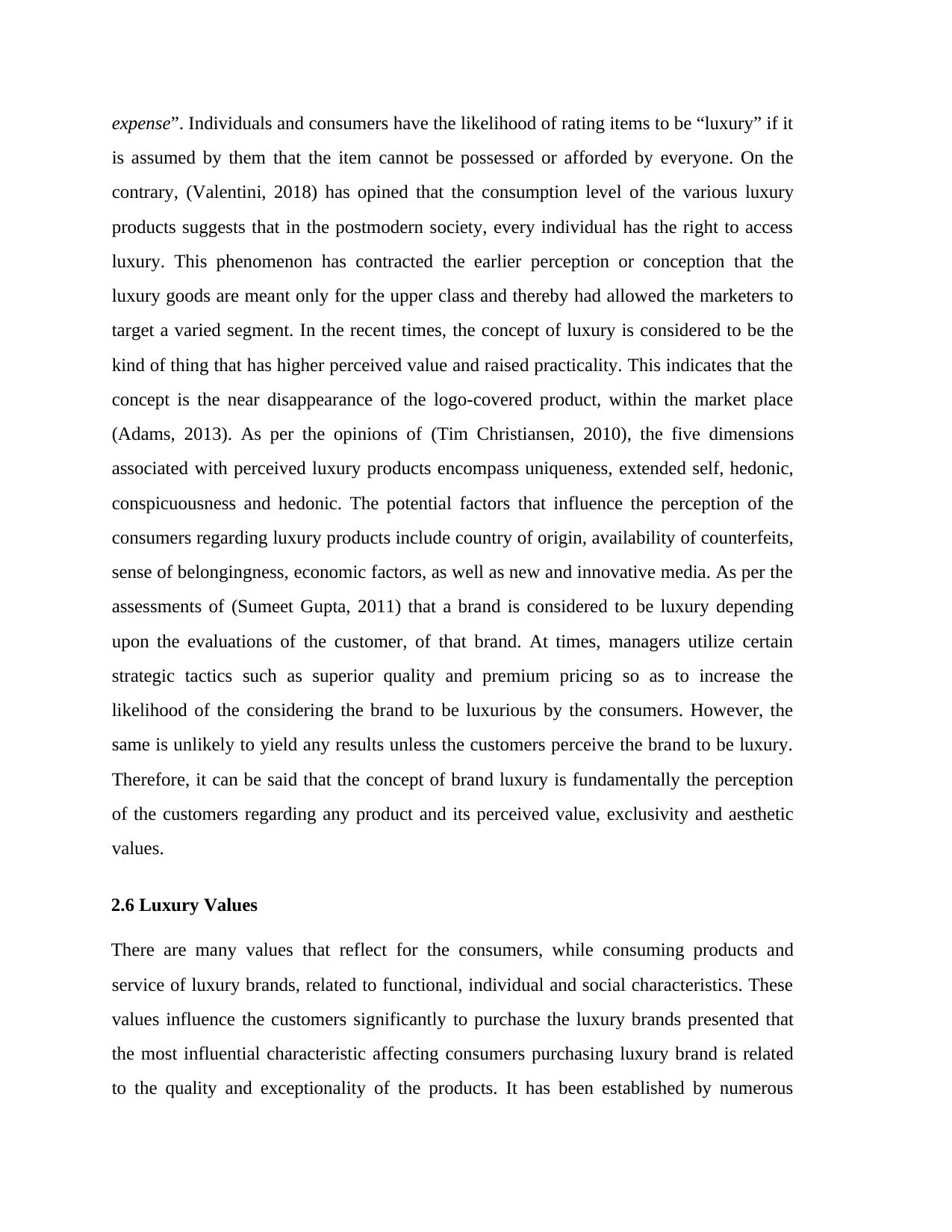
expense”. Individuals and consumers have the likelihood of rating items to be “luxury” if it
is assumed by them that the item cannot be possessed or afforded by everyone. On the
contrary, (Valentini, 2018) has opined that the consumption level of the various luxury
products suggests that in the postmodern society, every individual has the right to access
luxury. This phenomenon has contracted the earlier perception or conception that the
luxury goods are meant only for the upper class and thereby had allowed the marketers to
target a varied segment. In the recent times, the concept of luxury is considered to be the
kind of thing that has higher perceived value and raised practicality. This indicates that the
concept is the near disappearance of the logo-covered product, within the market place
(Adams, 2013). As per the opinions of (Tim Christiansen, 2010), the five dimensions
associated with perceived luxury products encompass uniqueness, extended self, hedonic,
conspicuousness and hedonic. The potential factors that influence the perception of the
consumers regarding luxury products include country of origin, availability of counterfeits,
sense of belongingness, economic factors, as well as new and innovative media. As per the
assessments of (Sumeet Gupta, 2011) that a brand is considered to be luxury depending
upon the evaluations of the customer, of that brand. At times, managers utilize certain
strategic tactics such as superior quality and premium pricing so as to increase the
likelihood of the considering the brand to be luxurious by the consumers. However, the
same is unlikely to yield any results unless the customers perceive the brand to be luxury.
Therefore, it can be said that the concept of brand luxury is fundamentally the perception
of the customers regarding any product and its perceived value, exclusivity and aesthetic
values.
2.6 Luxury Values
There are many values that reflect for the consumers, while consuming products and
service of luxury brands, related to functional, individual and social characteristics. These
values influence the customers significantly to purchase the luxury brands presented that
the most influential characteristic affecting consumers purchasing luxury brand is related
to the quality and exceptionality of the products. It has been established by numerous
is assumed by them that the item cannot be possessed or afforded by everyone. On the
contrary, (Valentini, 2018) has opined that the consumption level of the various luxury
products suggests that in the postmodern society, every individual has the right to access
luxury. This phenomenon has contracted the earlier perception or conception that the
luxury goods are meant only for the upper class and thereby had allowed the marketers to
target a varied segment. In the recent times, the concept of luxury is considered to be the
kind of thing that has higher perceived value and raised practicality. This indicates that the
concept is the near disappearance of the logo-covered product, within the market place
(Adams, 2013). As per the opinions of (Tim Christiansen, 2010), the five dimensions
associated with perceived luxury products encompass uniqueness, extended self, hedonic,
conspicuousness and hedonic. The potential factors that influence the perception of the
consumers regarding luxury products include country of origin, availability of counterfeits,
sense of belongingness, economic factors, as well as new and innovative media. As per the
assessments of (Sumeet Gupta, 2011) that a brand is considered to be luxury depending
upon the evaluations of the customer, of that brand. At times, managers utilize certain
strategic tactics such as superior quality and premium pricing so as to increase the
likelihood of the considering the brand to be luxurious by the consumers. However, the
same is unlikely to yield any results unless the customers perceive the brand to be luxury.
Therefore, it can be said that the concept of brand luxury is fundamentally the perception
of the customers regarding any product and its perceived value, exclusivity and aesthetic
values.
2.6 Luxury Values
There are many values that reflect for the consumers, while consuming products and
service of luxury brands, related to functional, individual and social characteristics. These
values influence the customers significantly to purchase the luxury brands presented that
the most influential characteristic affecting consumers purchasing luxury brand is related
to the quality and exceptionality of the products. It has been established by numerous
⊘ This is a preview!⊘
Do you want full access?
Subscribe today to unlock all pages.

Trusted by 1+ million students worldwide
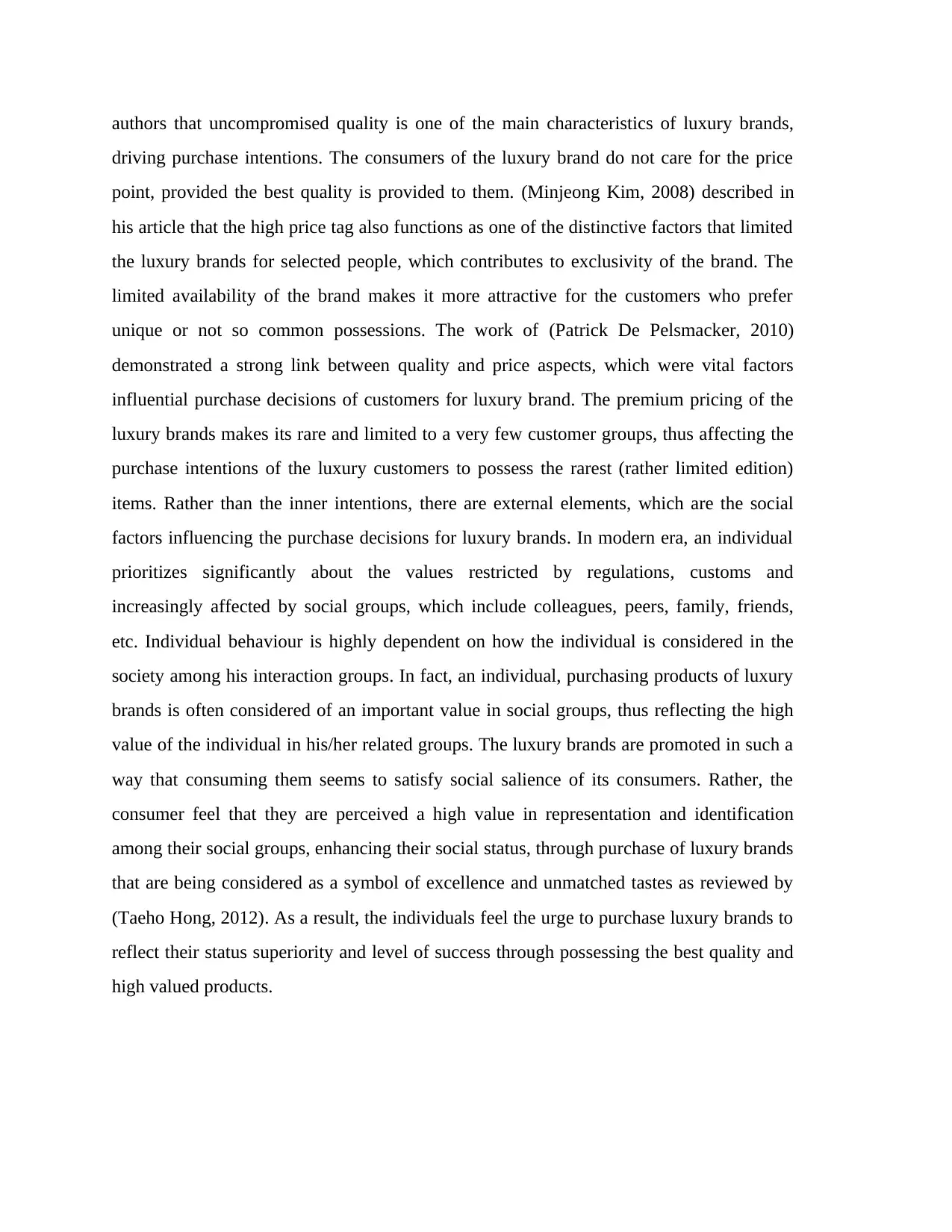
authors that uncompromised quality is one of the main characteristics of luxury brands,
driving purchase intentions. The consumers of the luxury brand do not care for the price
point, provided the best quality is provided to them. (Minjeong Kim, 2008) described in
his article that the high price tag also functions as one of the distinctive factors that limited
the luxury brands for selected people, which contributes to exclusivity of the brand. The
limited availability of the brand makes it more attractive for the customers who prefer
unique or not so common possessions. The work of (Patrick De Pelsmacker, 2010)
demonstrated a strong link between quality and price aspects, which were vital factors
influential purchase decisions of customers for luxury brand. The premium pricing of the
luxury brands makes its rare and limited to a very few customer groups, thus affecting the
purchase intentions of the luxury customers to possess the rarest (rather limited edition)
items. Rather than the inner intentions, there are external elements, which are the social
factors influencing the purchase decisions for luxury brands. In modern era, an individual
prioritizes significantly about the values restricted by regulations, customs and
increasingly affected by social groups, which include colleagues, peers, family, friends,
etc. Individual behaviour is highly dependent on how the individual is considered in the
society among his interaction groups. In fact, an individual, purchasing products of luxury
brands is often considered of an important value in social groups, thus reflecting the high
value of the individual in his/her related groups. The luxury brands are promoted in such a
way that consuming them seems to satisfy social salience of its consumers. Rather, the
consumer feel that they are perceived a high value in representation and identification
among their social groups, enhancing their social status, through purchase of luxury brands
that are being considered as a symbol of excellence and unmatched tastes as reviewed by
(Taeho Hong, 2012). As a result, the individuals feel the urge to purchase luxury brands to
reflect their status superiority and level of success through possessing the best quality and
high valued products.
driving purchase intentions. The consumers of the luxury brand do not care for the price
point, provided the best quality is provided to them. (Minjeong Kim, 2008) described in
his article that the high price tag also functions as one of the distinctive factors that limited
the luxury brands for selected people, which contributes to exclusivity of the brand. The
limited availability of the brand makes it more attractive for the customers who prefer
unique or not so common possessions. The work of (Patrick De Pelsmacker, 2010)
demonstrated a strong link between quality and price aspects, which were vital factors
influential purchase decisions of customers for luxury brand. The premium pricing of the
luxury brands makes its rare and limited to a very few customer groups, thus affecting the
purchase intentions of the luxury customers to possess the rarest (rather limited edition)
items. Rather than the inner intentions, there are external elements, which are the social
factors influencing the purchase decisions for luxury brands. In modern era, an individual
prioritizes significantly about the values restricted by regulations, customs and
increasingly affected by social groups, which include colleagues, peers, family, friends,
etc. Individual behaviour is highly dependent on how the individual is considered in the
society among his interaction groups. In fact, an individual, purchasing products of luxury
brands is often considered of an important value in social groups, thus reflecting the high
value of the individual in his/her related groups. The luxury brands are promoted in such a
way that consuming them seems to satisfy social salience of its consumers. Rather, the
consumer feel that they are perceived a high value in representation and identification
among their social groups, enhancing their social status, through purchase of luxury brands
that are being considered as a symbol of excellence and unmatched tastes as reviewed by
(Taeho Hong, 2012). As a result, the individuals feel the urge to purchase luxury brands to
reflect their status superiority and level of success through possessing the best quality and
high valued products.
Paraphrase This Document
Need a fresh take? Get an instant paraphrase of this document with our AI Paraphraser
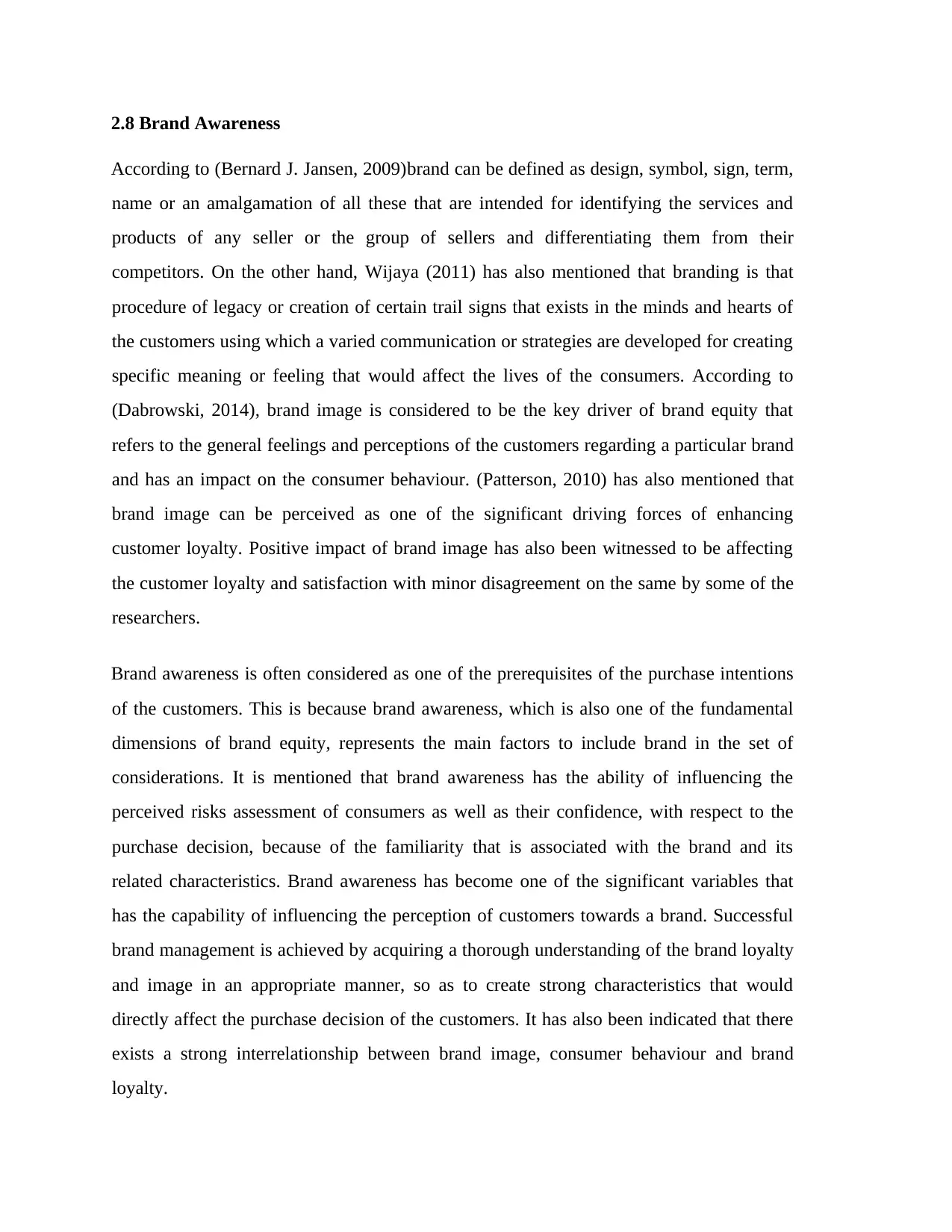
2.8 Brand Awareness
According to (Bernard J. Jansen, 2009)brand can be defined as design, symbol, sign, term,
name or an amalgamation of all these that are intended for identifying the services and
products of any seller or the group of sellers and differentiating them from their
competitors. On the other hand, Wijaya (2011) has also mentioned that branding is that
procedure of legacy or creation of certain trail signs that exists in the minds and hearts of
the customers using which a varied communication or strategies are developed for creating
specific meaning or feeling that would affect the lives of the consumers. According to
(Dabrowski, 2014), brand image is considered to be the key driver of brand equity that
refers to the general feelings and perceptions of the customers regarding a particular brand
and has an impact on the consumer behaviour. (Patterson, 2010) has also mentioned that
brand image can be perceived as one of the significant driving forces of enhancing
customer loyalty. Positive impact of brand image has also been witnessed to be affecting
the customer loyalty and satisfaction with minor disagreement on the same by some of the
researchers.
Brand awareness is often considered as one of the prerequisites of the purchase intentions
of the customers. This is because brand awareness, which is also one of the fundamental
dimensions of brand equity, represents the main factors to include brand in the set of
considerations. It is mentioned that brand awareness has the ability of influencing the
perceived risks assessment of consumers as well as their confidence, with respect to the
purchase decision, because of the familiarity that is associated with the brand and its
related characteristics. Brand awareness has become one of the significant variables that
has the capability of influencing the perception of customers towards a brand. Successful
brand management is achieved by acquiring a thorough understanding of the brand loyalty
and image in an appropriate manner, so as to create strong characteristics that would
directly affect the purchase decision of the customers. It has also been indicated that there
exists a strong interrelationship between brand image, consumer behaviour and brand
loyalty.
According to (Bernard J. Jansen, 2009)brand can be defined as design, symbol, sign, term,
name or an amalgamation of all these that are intended for identifying the services and
products of any seller or the group of sellers and differentiating them from their
competitors. On the other hand, Wijaya (2011) has also mentioned that branding is that
procedure of legacy or creation of certain trail signs that exists in the minds and hearts of
the customers using which a varied communication or strategies are developed for creating
specific meaning or feeling that would affect the lives of the consumers. According to
(Dabrowski, 2014), brand image is considered to be the key driver of brand equity that
refers to the general feelings and perceptions of the customers regarding a particular brand
and has an impact on the consumer behaviour. (Patterson, 2010) has also mentioned that
brand image can be perceived as one of the significant driving forces of enhancing
customer loyalty. Positive impact of brand image has also been witnessed to be affecting
the customer loyalty and satisfaction with minor disagreement on the same by some of the
researchers.
Brand awareness is often considered as one of the prerequisites of the purchase intentions
of the customers. This is because brand awareness, which is also one of the fundamental
dimensions of brand equity, represents the main factors to include brand in the set of
considerations. It is mentioned that brand awareness has the ability of influencing the
perceived risks assessment of consumers as well as their confidence, with respect to the
purchase decision, because of the familiarity that is associated with the brand and its
related characteristics. Brand awareness has become one of the significant variables that
has the capability of influencing the perception of customers towards a brand. Successful
brand management is achieved by acquiring a thorough understanding of the brand loyalty
and image in an appropriate manner, so as to create strong characteristics that would
directly affect the purchase decision of the customers. It has also been indicated that there
exists a strong interrelationship between brand image, consumer behaviour and brand
loyalty.
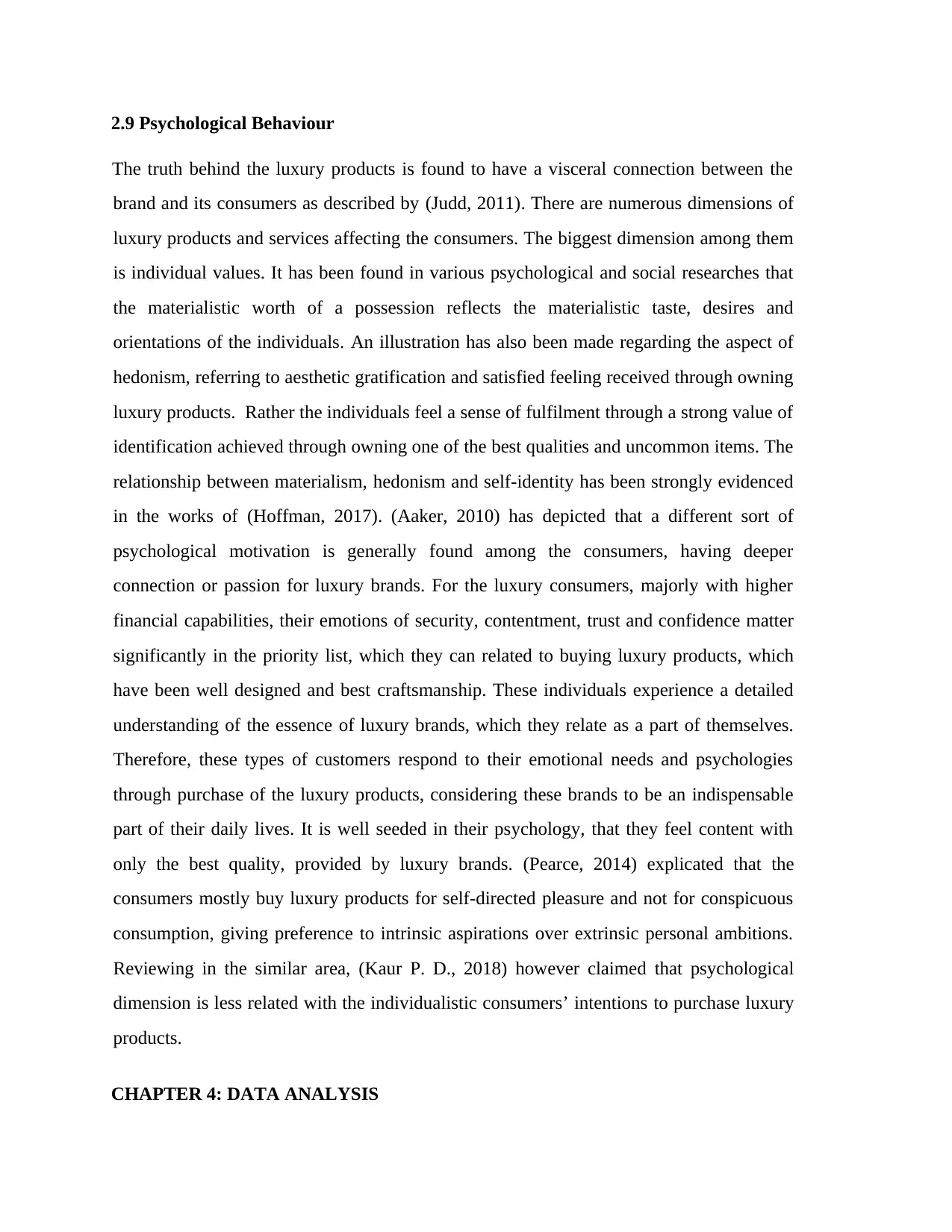
2.9 Psychological Behaviour
The truth behind the luxury products is found to have a visceral connection between the
brand and its consumers as described by (Judd, 2011). There are numerous dimensions of
luxury products and services affecting the consumers. The biggest dimension among them
is individual values. It has been found in various psychological and social researches that
the materialistic worth of a possession reflects the materialistic taste, desires and
orientations of the individuals. An illustration has also been made regarding the aspect of
hedonism, referring to aesthetic gratification and satisfied feeling received through owning
luxury products. Rather the individuals feel a sense of fulfilment through a strong value of
identification achieved through owning one of the best qualities and uncommon items. The
relationship between materialism, hedonism and self-identity has been strongly evidenced
in the works of (Hoffman, 2017). (Aaker, 2010) has depicted that a different sort of
psychological motivation is generally found among the consumers, having deeper
connection or passion for luxury brands. For the luxury consumers, majorly with higher
financial capabilities, their emotions of security, contentment, trust and confidence matter
significantly in the priority list, which they can related to buying luxury products, which
have been well designed and best craftsmanship. These individuals experience a detailed
understanding of the essence of luxury brands, which they relate as a part of themselves.
Therefore, these types of customers respond to their emotional needs and psychologies
through purchase of the luxury products, considering these brands to be an indispensable
part of their daily lives. It is well seeded in their psychology, that they feel content with
only the best quality, provided by luxury brands. (Pearce, 2014) explicated that the
consumers mostly buy luxury products for self-directed pleasure and not for conspicuous
consumption, giving preference to intrinsic aspirations over extrinsic personal ambitions.
Reviewing in the similar area, (Kaur P. D., 2018) however claimed that psychological
dimension is less related with the individualistic consumers’ intentions to purchase luxury
products.
CHAPTER 4: DATA ANALYSIS
The truth behind the luxury products is found to have a visceral connection between the
brand and its consumers as described by (Judd, 2011). There are numerous dimensions of
luxury products and services affecting the consumers. The biggest dimension among them
is individual values. It has been found in various psychological and social researches that
the materialistic worth of a possession reflects the materialistic taste, desires and
orientations of the individuals. An illustration has also been made regarding the aspect of
hedonism, referring to aesthetic gratification and satisfied feeling received through owning
luxury products. Rather the individuals feel a sense of fulfilment through a strong value of
identification achieved through owning one of the best qualities and uncommon items. The
relationship between materialism, hedonism and self-identity has been strongly evidenced
in the works of (Hoffman, 2017). (Aaker, 2010) has depicted that a different sort of
psychological motivation is generally found among the consumers, having deeper
connection or passion for luxury brands. For the luxury consumers, majorly with higher
financial capabilities, their emotions of security, contentment, trust and confidence matter
significantly in the priority list, which they can related to buying luxury products, which
have been well designed and best craftsmanship. These individuals experience a detailed
understanding of the essence of luxury brands, which they relate as a part of themselves.
Therefore, these types of customers respond to their emotional needs and psychologies
through purchase of the luxury products, considering these brands to be an indispensable
part of their daily lives. It is well seeded in their psychology, that they feel content with
only the best quality, provided by luxury brands. (Pearce, 2014) explicated that the
consumers mostly buy luxury products for self-directed pleasure and not for conspicuous
consumption, giving preference to intrinsic aspirations over extrinsic personal ambitions.
Reviewing in the similar area, (Kaur P. D., 2018) however claimed that psychological
dimension is less related with the individualistic consumers’ intentions to purchase luxury
products.
CHAPTER 4: DATA ANALYSIS
⊘ This is a preview!⊘
Do you want full access?
Subscribe today to unlock all pages.

Trusted by 1+ million students worldwide
1 out of 25
Related Documents
Your All-in-One AI-Powered Toolkit for Academic Success.
+13062052269
info@desklib.com
Available 24*7 on WhatsApp / Email
![[object Object]](/_next/static/media/star-bottom.7253800d.svg)
Unlock your academic potential
Copyright © 2020–2025 A2Z Services. All Rights Reserved. Developed and managed by ZUCOL.





